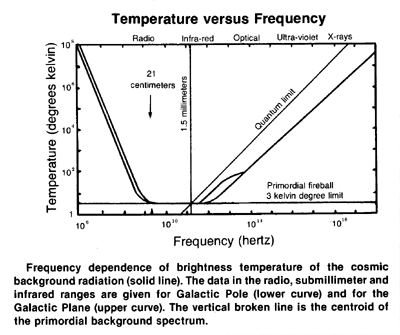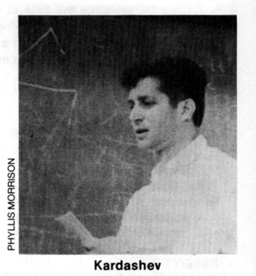The examples given in the first part of this article in the last issue of COSMIC SEARCH cover only a few of the possible trends in the activities of civilizations. All of these examples, however, seem to be directly related to the correct strategy of searching for civilizations, a subject we shall
now discuss.
Right and Wrong Search Strategies
Two concepts and two extreme strategies of search for extraterrestrial civilizations are now being
discussed in the scientific community:
(1) The Concept of "terrestrial chauvinism": Each civilization stabilizes or perishes at a level of development close to ours (see the conclusions and recommendations of the "Club of Rome" regarding strict limits to population and its activities.)
Search Strategy: Search for civilizations of our type, i.e. belonging to a planetary system, using communication techniques similar to ours: monochromatic signals from the nearest Sun-like stars, gradually extending the survey radius.
(2) The Evolutionary Concept: Civilizations can attain much higher evolutionary level than ours.
Search Strategy: Search for super-civilizations with more powerful transmitting systems and highly advanced engineering activity. There are two directions for such studies. First, study the character of the most powerful (and often most distant) known sources of radiation in the Universe. Only after we are certain that their functioning is natural, is it worthwhile to begin surveys of weaker objects. Second, search for new and powerful sources of radiation, mainly in the poorly investigated regions of the electromagnetic spectrum.
Therefore, it would be worthwhile to search for meaningful monochromatic or pulsed signals from the
center of the Galaxy, from nuclei of other galaxies and quasars, from other classes of astronomical objects (if there are grounds to relate them to the evolution of civilizations), to search for traces of astro-engineering activities in these objects, with maps made with a super-high resolution, and to investigate in detail any "peculiar" sources which may be discovered (for instance, very large structures might be discovered, some of which might move at nearly relativistic velocities).
An optimum wavelength range to be used in the search for artificial signals from the nucleus of our
Galaxy and from the nuclei of other galaxies and quasars differs radically from the range most favorable for contacts with the nearest stars. The former objects whose nature is still unknown, are characterized by an intense natural radio emission of synchrotron origin, covering the whole radio-frequency range. Furthermore, radio waves are heavily scattered in the clouds of plasma surrounding these objects. Both of these factors imply that the most favorable search range is probably at millimeter wavelengths, near the intensity maximum of the relic background, rather than near a 21 centimeter wavelength. It is of interest that if a civilization in a distant extragalactic object sends signals in this spectral region, then, despite changes in the background spectrum during the signal propagation, the signals will also appear to arrive near the maximum intensity of the primordial fireball background as seen by observers in our Galaxy. For observers in our Galaxy, the spectral region of the maximum intensity for the primordial background corresponds to a wavelength of 1.7 millimeters. An attempt should be made to discover radiation in this region carrying specific information as well as thermal radiation from large astro-engineering structures. Therefore, it would be extremely interesting to investigate the nature of the radio point source (of size smaller than that of the solar system) which is located in the very center of our Galaxy and which radiates at short waves, as well as the nature of several sources of infra-red radiation near the Galactic Center whose temperature is close to room temperature.
Is there a danger of losing a sense of sound judgement if actual, observed astrophysical phenomena are interpreted in this way? At present, it is expedient to keep in mind both possibilities when unknown objects are studied: a "natural" explanation of objects which are evolutionary in the lifeless Universe, and models of objects which might be called "cosmic miracles" but which might also be the results of the long evolution of intelligent life in the Universe. Both concepts may stimulate experiments to show which of the two is closer to the truth.
Finally, several appraisals are given of the possibility of detecting at our present technological level, extraterrestrial civilizations. Such calculations are very reliable because they are based on the well-known propagation conditions for electromagnetic signals in space. The temperature versus frequency chart [below] shows the frequency dependence of brightness temperature of the cosmic background radiation and the location of the two main SETI search ranges. The range near the famous radio line of hydrogen at 21 centimeters corresponds to the presumption of omnidirectional transmission, and is intended for searches for signals from the nearest planetary systems.

The range near the centroid of the relic background spectrum (wavelength about 1.5 millimeters) corresponds to the most economical strategy of space communication, namely, to align the transmitting and receiving antennas, and to send the radiation and the information it carries in a narrow beam. This is the optimum range for small as well as for large distances (the spreading of a beam of radiation is smaller in the millimeter range than it is near 21 centimeters). The millimeter range may also be used for the detection of large astro-engineering structures. For such a search, very high angular resolution is needed, which may be achieved only by radio with Very Long Baseline Interferometers (VLBI).
The first millimeter search for meaningful signals as well as for thermal emission or scattered radiation from astro-engineering structures may be conducted with existing and projected radio telescopes in both millimeter and centimeter ranges. But for positive results, it is probably necessary to have a special, very large radio telescope — an interferometer with a baseline much larger than the Earth's diameter. Such a large radio telescope must be constructed not on the Earth, but in space — in a geostationary, or more distant, orbit. Such an instrument would be able to completely reject the tremendous radio interference associated with the activity of terrestrial civilization. The estimated expenditure for such an instrument, with reflector sizes of several kilometers, may be even less than for a ground system with the same collecting area, because of the absence of gravity. The construction of such telescopes will be possible in the next decade. A project on space radio telescopes to be built with reflectors up to 10 kilometers in diameter was discussed by V.I. Bajakas, A.S. Gvamichava et al. in their paper "Infinitely Built-up Space Radio Telescope" delivered at the International Astronomical Union Congress in Prague in 1977. (See the SEnTInel in the January 1979 issue of COSMIC SEARCH). A similar project was proposed in the U.S.A. The natural radiation of astro-engineering structures, or their absorption or reflection of the background radiation or information-carrying signals of civilizations, could be detected at distances comparable with the curvature radius of the Universe with such radiotelescopes.
The graph of distance versus telescope size [below] illustrates these conclusions. Estimates are made for possible detection of astro-engineering structures of the Dyson-Sphere type at temperatures of 3 and 300 degrees kelvin radiating the same power as the sun does, but in the infrared and millimeter range, as well as for meaningful signals of about the same power sent by a supercivilization. The graph also shows detection capabilities for transmitters similar to those available on Earth, corresponding to the concept of "terrestrial chauvinism" (lower curves). Note that the range of detection, for the "evolutionary" concept (corresponding to the upper curves) is many orders of magnitude larger.
Conclusions
Astrophysical investigation as well as data provided by biology, cybernetics and other sciences show
that the detection of extraterrestrial civilizations is highly probable. All of the original concepts about what these civilizations may turn out to be and what search strategy should be followed must now be radically revised. In our opinion the only promising concept is the assumption that super-civilizations exist. The way to detect them is to conduct the following series of experiments:
First, search for and study blackbody-radiation sources whose maximum intensity falls in the millimeter and infrared ranges, with the aim of detecting very large structures. Such structures might also be detected by their screening effect or by the way they reflect the cosmic background radiation in various spectral regions. Very promising approaches might be synthesis maps of peculair sources by means of superlong-baseline interferometers, or the detection of very compact objects by scintillation (caused by the modulation of radiation passing through inhomogeneous plasma of space). Superhigh resolution in the interferometer regime and in scintillation observations requires radio telescopes separated by distances exceeding the Earth's diameter.
Second, search for meaningful signals from promising objects. The optimum wavelength range for such signals should be calculated, relative to the background radio emission near the respective source and the conditions of signal propagation in the plasma along the line of sight. The millimeter range is especially promising, near the maximum of the relic background radiation. These experiments might either reveal that some known astronomical objects are actually related to the activities of civilizations or else lead to the detection of entirely new classes of natural astrophysical sources.
If well-designed experiments based on the logically consistent Evolutionary Concept are carried out with future, largest-possible radio telescopes, the search for extraterrestrial civilizations could yield positive results within the first ten years, thereby giving mankind access to the vast store of information acquired in the Universe over a time span of billions of years.
I thank L. Gindylys, D. Downes, M. Popov, I.S. Shklovsky and V. Slysh for valuable discussions and assistance.
 Dr. Nikolai S. Kardashev is a member of the Space Research Institute, Academy of Sciences, Moscow, U.S.S.R. His photograph appeared with the first installment of his article (in issue number 7). [However, I have reproduced that photograph here. — Wepbpage Editor] Dr. Kardashev is a member of the Editorial Board of COSMIC SEARCH.
Dr. Nikolai S. Kardashev is a member of the Space Research Institute, Academy of Sciences, Moscow, U.S.S.R. His photograph appeared with the first installment of his article (in issue number 7). [However, I have reproduced that photograph here. — Wepbpage Editor] Dr. Kardashev is a member of the Editorial Board of COSMIC SEARCH.
![[NAAPO Logo]](../../Images/NAAPOsm.jpg)
![[NAAPO Logo]](../../Images/NAAPOsm.jpg)